#The Royal School of Needlework
Photo
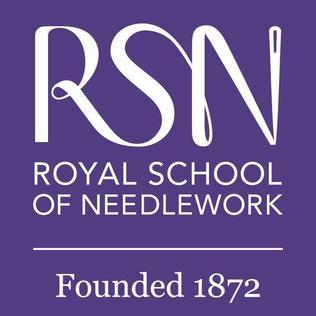
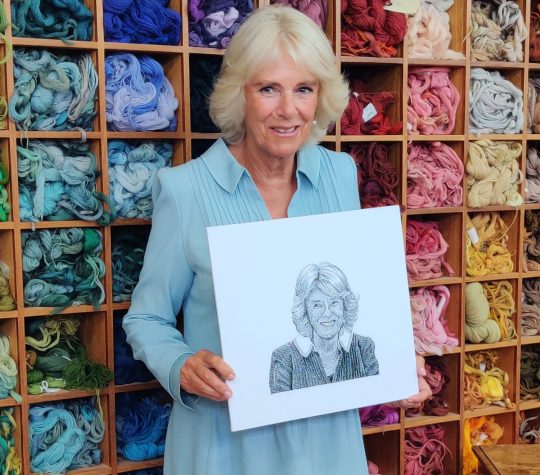
Queen Camilla’s Patronages
The Royal School of Needlework
Based at the magnificent Hampton Court Palace, south-west London, we offer a thriving education programme for everyone from beginner to degree level. We teach Online and Onsite at venues across the UK in Hampton Court Palace (London), Portsmouth, Bristol, Rugby, Durham and Glasgow as well as internationally in America and Japan. We also host an annual International Summer School.
Our renowned Embroidery Studio creates stunning bespoke embroidery for fashion, art and royalty, as well as expertly restoring and conserving valuable and historical embroidered pieces.
28 notes
·
View notes
Text
#Talks on Demand: The Salve of Sewing With RSN 150 Ambassador Clare Hunter#Handiworks#The Royal School of Needlework#Tumblr Staff Has Ruined Links Now And I Hate Them For It#Bookshelf
0 notes
Text
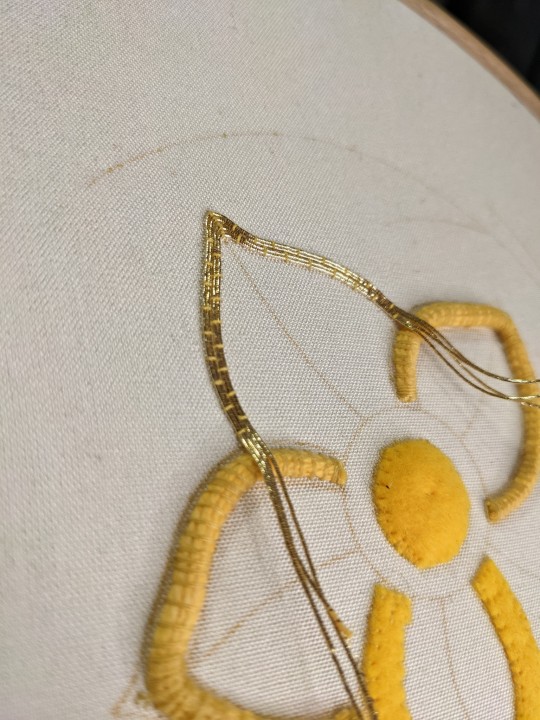

Goldwork course - row two of the petal. Each row consists of two pieces of passing.
#hand embroidery#embroidery#goldwork#fabric crafts#needlecraft#needlework#royal school of needlework
14 notes
·
View notes
Text

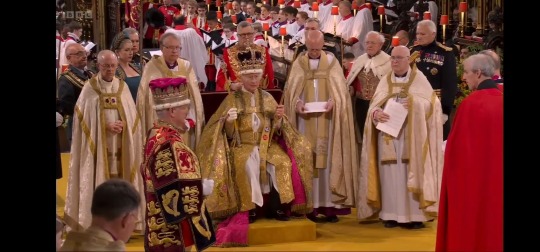
It's no surprise that King Charles III kept sustainability in mind when choosing what to wear on the day of his coronation.
Considering the monarch's lifelong passion for protecting the environment, it's natural that he would choose to make some eco-friendly sartorial choices.
Eco-friendly or not, the king's coronation day look was far from plain.
Upon arrival and departure, Charles wore two different grand robes, per royal tradition.
During the ceremony, King Charles III reused golden vestments, which have been worn for nearly every coronation since 1821, including the Colobium Sindonis, the Supertunica, the Imperial Mantle, the Coronation Sword Belt, and the Coronation Glove.
Buckingham Palace notes that "it is customary for the Supertunica and the Imperial Mantle to be reused, but the reuse of the other objects were made "in the interests of sustainability and efficiency."
Ahead, we break down the different parts of the king's coronation look.
The Robe of State
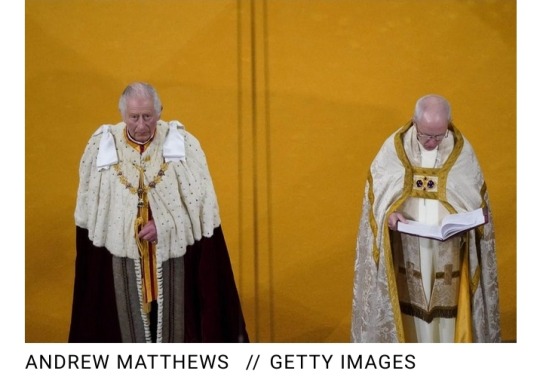
This magnificent crimson velvet robe was originally worn during King George VI's 1937 coronation.
It has since been conserved by the Royal School of Needlework and Ede and Ravenscroft.
The Colobium Sindonis
(Latin for "shroud tunic")

📷: via Buzzfeed
This piece appears as a white linen tunic with a collar fastened with a single button, fashioned after a priest's alb.
This particular piece of clothing has a sentimental meaning to Charles, as it was previously worn by his grandfather, George VI, during his 1937 coronation.
The Supertunica

This sleeved gold coat was originally made in 1911 for George V's coronation.
George VI and Queen Elizabeth II subsequently wore it at their own crowning ceremonies.
Though it is a relatively modern piece compared to other coronation regalia, it is designed in the same style as coats from medieval coronations, which is in turn influenced by priestly and religious vestments.
This Supertunica features goldwork techniques and embroidery, which was originally completed in 1911 by the Ladies Work Society.
The Imperial Mantle
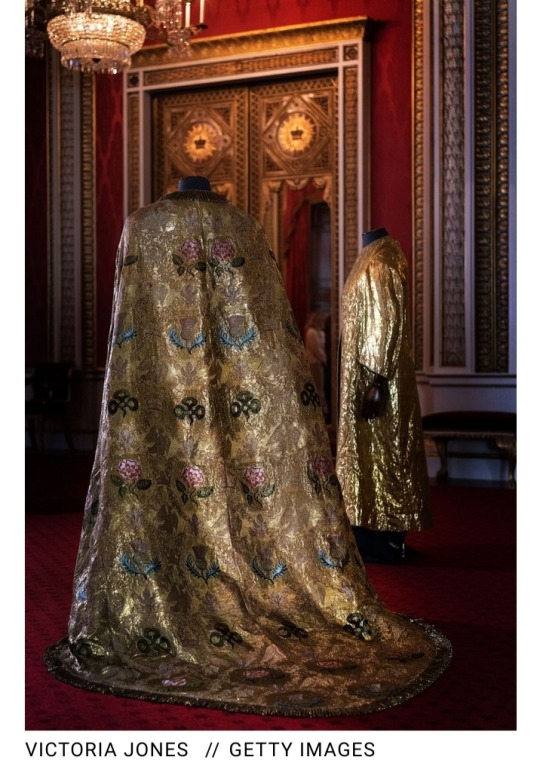
Worn over the Supertunica, the Imperial Mantle appears like a robe.
It's composed of cloth of gold, gold, silver and silk thread, silk, gold bullion fringe, and a gold clasp.
Additionally, symbolic shapes cover the surface of the Imperial Mantle, including roses, thistles, shamrocks, crowns, eagles, and fleurs-de-lis.
This piece was originally created for George IV's 1821 coronation.
It is the oldest amongst the coronation vestments.
The Coronation Sword Belt
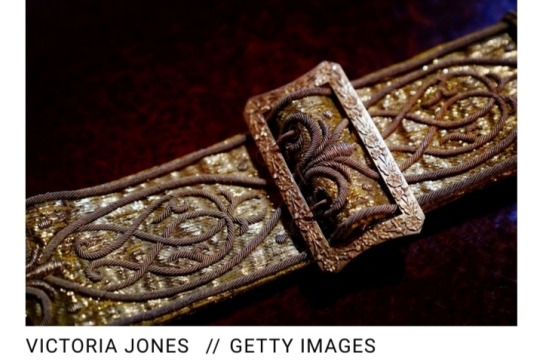
Also known as the Girdle, the Coronation Sword Belt wraps around the Supertunica, with the Jewelled Sword of Offering then fastened at the monarch's waist.
Traditionally, this piece is made anew for each coronation, but Charles has instead chosen to reuse the same Sword Belt that his grandfather, George VI, wore during his 1937 ceremony.
This one features cloth of gold, red silk, and a gold buckle and clip.
The Coronation Glove
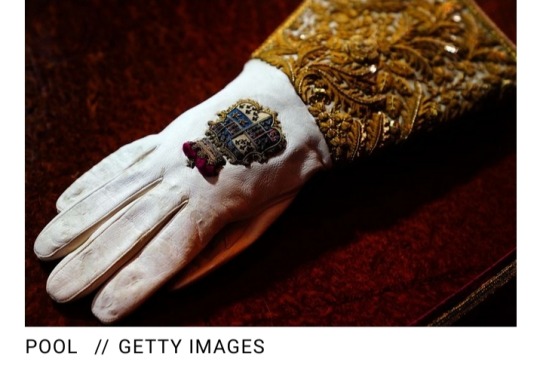
The Coronation Glove, also known as the gauntlet, is worn on the monarch's right hand to hold the Sovereign's Sceptre during the moment he is crowned.
Like the Coronation Sword Belt, Charles chose to reuse the hand piece that his grandfather, George VI, wore during his own coronation in 1937, rather than have one made entirely new.
This piece is made up of white leather and further features gilt metal thread embroidery depicting the national emblems of the Tudor Rose, thistle, shamrock, oak leaves, and acorns.
On the back of the glove's hand, there is an embroidered ducal coronet in red velvet above the coat of arms of the family of the Dukes of Newcastle.
The Robe of Estate
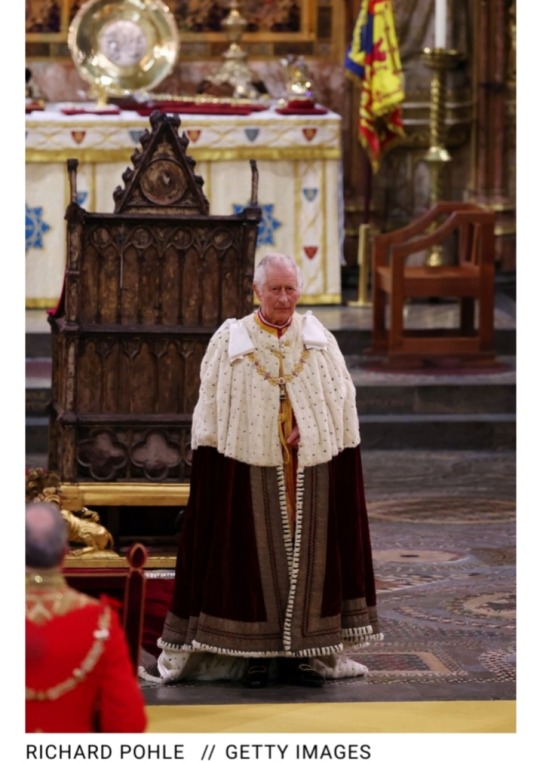
To leave Westminster Abbey, Charles put on this purple silk velvet robe that was, again, once worn by George VI. It includes elegant gold embroidery.
#King Charles III#Coronation Service 2023#Coronation 2023#British Royal Family#Coronation Outfit#The Robe of State#The Colobium Sindonis#The Supertunica#The Imperial Mantle#The Coronation Sword Belt#The Coronation Glove#Girdle#Gauntlet#Jewelled Sword of Offering#Sovereign's Sceptre#Royal School of Needlework#Ede and Ravenscroft#Ladies Work Society#George IV#George V#George VI#Elizabeth II
5 notes
·
View notes
Text
Ryan Yip explains what a fabulous resource for sewers of all kinds the Royal School of Needlework Stitch Bank is.
#sewing#embroidery#stitches#database#needlework#textiles#fashion#fashion history#costume design#costume history#couture#ryan yip#tiktok#sewing resources#dressmaking#embellishment#decorative#video
69 notes
·
View notes
Note
Hi! Can you give us a huge insight of Tatiana Nikolaevna's personality? I would be interested in some rare quotes said by someone who met her! (cos she is my favorite royal like ever and I'm hopeless obsessed with her 😫)
Hello! Of course, here are some of my favourite rarer quotes about Tatiana - or from Tatiana herself - which I think give a great insight into her personality....

"Tatiana Nicolaievna had holly different… character. Less serious than her elder sister she was also more positive. In her could already be discerned a strong tendency to dominate to impose her authority coquette. She saw and noticed everything, and often made observations to her sisters, who because of it nicknamed her ‘the governess'… she took great care of her appearance and was it was said that she resembled her…”She's already a woman," said the Empress about her that year. She was the favourite in the family. She was very superstitious. One day she wrote to a graphologist, a fortune teller, to ask that she inform her about the destiny in store for her. By an intermediary, the other had sent to her a note couch in these terms: "A fatal destiny awaits you" Thereafter, the Grand Duchess never stopped bombarding her tutor, Petrov with questions such as "What does that mean? How am I to interpret this letter?"" - Alexander Spiridovich, Last Years as Tsarskoe Selo, volume 2
"It was Tatiana Nicholaievna who would call N.P. Sabline by telephone to transmit ‘Papa’s’ order to come with his friends to play tennis." - Alexander Spiridovich, Last Years as Tsarskoe Selo, volume 2
"As for poor Alexei Nikolaevich, he was as if rooted to the armchair the whole time [unwell]. It was touching to see his sister, Tatiana Nicholaievna, lavishing attention on him before the luncheon." - Alexander Spiridovich, Last Years as Tsarskoe Selo, volume 2
"In [Alexandra's] eyes, as well as in those of her sister, Tatiana Nicholalevna, all that was Russian was superior to all the rest. To try, even jokingly, to lower something Russian in favour of something foreign was to expose oneself to losing her sympathy forever." - Alexander Spiridovich, Last Years as Tsarskoe Selo, volume 2
"Russian was taught by Peter Vassilievitch Petrov, whom I had had myself as a teacher at the Pavlovskoe military school. Petrov was already an elderly man, very gentle, and very good hearted. He held the Tsar's children in affection and they, in turn, were attached to him as if to a kindly relative. Often, when they were alone with him, the Grand Duchesses used to play with him, shouting, laughing, pushing him, and generally hauling him about without mercy. It was Tatiana Nicholaievna, graceful and agile as a gazelle, who would always give the signal on these occasions and direct the games. She was, at that time, a very pale little girl. One day, Petrov asked Olga Nicholaievna to name a white object for him.
My blouse, replied the Grand Duchess.
And a black object?
My slate pencil.
And a green one?
My sister Tatiana.
That really was the tint of her complexion." - Alexander Spiridovich, Last Years as Tsarskoe Selo, volume 1
"[Alexandra] herself taught them sewing and needlework, her best pupil being Tatiana, who had an extraordinary talent for all kinds of handwork. She not only made beautiful blouses and other garments, embroideries and crochets, but she was able on occasions to arrange her mother’s long hair, and to dress her as well as a professional maid." - Anna Vyrubova, Memories of the Russian Court
"Suddenly [whilst watching a cinematograph] the bigger girl [in the movie] snatched a toy from the little one who, however, held on to it and refused to give it up. Foiled in her attempts, the elder seized a spoon and pounded the little one with it, who quickly relinquished the toy and began to cry. Tatiana wept to see the poor little one so ill-treated, but Olga was very quiet." - Margaretta Eagar, Six Years at the Russian Court
"One of the under-nurses was married last year. She had come to the palace straight from her school, at seventeen years of age, and was there for nearly seven years. She was naturally very much attached to the children, and when her last day came was in floods of tears all through the day, and the children were terribly distressed to see her in such grief. The little Grand Duchess Tatiana told her she could stay on if she liked, she knew we all loved her and would be sorry to part from her ; and then she came running to me to beg me not to send dear Tegla away. I answered that she might stay if she liked, but that she had promised to marry Vladislav ; it was her own wish, and I did not think she would like to break her word. The other girls gave a little party to celebrate her leaving us, and the young man was amongst the guests. When the girl heard that he had arrived her grief broke forth again. She realised that the time of parting had come, and the children cried most bitterly. Little Tatiana Nicolaivna took a sheet of paper and a pencil, and wrote with great difficulty a letter which I translate : " Vladislav, Be good with Tegla. Tatiana." She placed this letter in an envelope and printed in large letters on the envelope, Vladislav, and sent it to him by the housemaid. I went in later to speak to the man and wish him happiness. He pulled this letter out of his pocket, and with tears in his eyes begged me to thank the little Grand Duchess, and assure her that he would never forget to be good to Tegla. All the more, because it was Tatiana Nicolaivna' s wish. He always carries the letter about with him. She came to visit us several times after her marriage and was very happy. Whenever she writes she always sends a special message to Tatiana to say that Vladislav is very good to her, and the little one looks so pleased and says, " Well, I am glad."" - Margaretta Eagar, Six Years at the Russian Court
"After coffee, I went for a walk with my pupils… They really liked to go to the shops and buy everything. Anastasia Nikolaevna was especially attracted to stored, where they sold doll shoes of various sizes… Tatiana Nikolaevna did not always accompany since the doctors found her heart was weak and she went with the Empress to take baths." - Sofia Ivanovna Tyutcheva, A Few Years Before the Catastrophe
"Alexandra's 594th letter to Nicholas, Sept 19 1916: …I do so want to get quicker well again, have more work to do & all lies upon Tatiana’s shoulders." - Joseph T. Fuhrmann, Nicholas and Alexandra: The Wartime Correspondence
The following are from Correspondence of the Russian Grand Duchesses: Letters of the Daughters of the Last Tsar by George Hawkins:
Tatiana to tutor PVP - 10 July 1906 - "Dear Petr Vasilievich! …Why did you write that I was not good? You mustn’t do that, you must write that I was a very good girl. Your devoted Naughty girl, Tatiana." -
Tatiana to PVP November 6th 1909 "…On these few lines I had 10 errors… I am so ashamed when I think about it"
Pierre Gilliard to Tatiana 25 May 1916 - "...It seems that purple is his [Dmitri Pavlovich] favourite colour… Alexis Nikolaevitch says that it is also yours…"
Letter from Alexandra to her brother and sister-in-law: 2 September 1911 …[after Stolypin's assassination] Tatiana came home very tearful and is still a little shaken whereas Olga put on a brave face throughout." - The Correspondence Of The Empress Alexandra Of Russia With Ernst Ludwig And Eleonore, Grand Duke And Duchess Of Hesse
Note from Anastasia to Tatiana - "1913 Aug. 4. My sweet Tatiana, please find out all about us and let us know through Shura about tomorrow, will we take off our caps for breakfast? Your Anastasia. Don’t forget." - Anastasia Romanov: The Tsar's Youngest Daughter Speaks Through Her Writings
Letter from Pierre Gilliard to Anastasia, Spring 1916: "…I already wrote a long letter to Tatiana Nikolaevna yesterday, but I don’t think I shall send it, otherwise I would not dare to go back to Tsarskoe Selo, I would fear for my life." - Anastasia Romanov: The Tsar's Youngest Daughter Speaks Through Her Writings
"4 December. ...The general atmosphere that lords over [us] nowadays does not inspire peace. As soon as dressings end, Tatiana Nikolaevna goes to do the injection, then sits down with K [officer]. The latter is constantly restless, first sits by the piano, playing something with one finger, chats a lot and fervently with the charming child. Varvara Afanasiyvna is appalled, what if Naryshkina walks in on this scene, Madame Zizi, she would die. Shakh-Bagov has fever, is in bed. Olga Nikolaevna sits by his bed constantly. The other couple also moved there, yesterday [they] sat by the bed and looked at a photo album. K. is being so coy. Tatiana Nikolaevna's small dear child's face cannot hide a thing, [it looks] pink, excited, Isn't this closeness, the physical contact harmful[?]. I feel scared. The others are jealous, angry, and I imagine they spread all sorts of [rumours] throughout the city and later beyond." - From the memoirs of V. I. Chebotareva
"Today Tatiana Nikolaevna walked with me upstairs after dressings, to do Popov’s dressing. The poor child is terribly embarrassed; grabs my hand: “So awfully embarrassing and frightening… one never knows whom to acknowledge and whom not to.”" - From the memoirs of V. I. Chebotareva, Sister of Mercy
"To the right of me sits the Grand Duchess Tatiana. She's a grand princess from head to toe, so aristocratic and regal. Her face is pale matte, only the cheeks are slightly rosy, as if pink satin is trying to escape from just under her thin skin. Her profile is flawlessly beautiful, as if cut from marble by a great artist. The widely set eyes provide uniqueness and originality to her face [...] The nurse's Red Cross kerchief is more flattering to her than to her sisters. She laughs more rarely than her sisters. Her face sometimes has a focused and stern expression. In those moments she looks like her mother. On the pale outlines of her face are traces of deep thoughts and sometimes even sadness. Without any words I feel that she is special, different from her sisters, despite their common traits of kindness and friendliness. I feel hers - is a wholly secluded and unique world." - From the memoirs of Sophia Ofrosimova, Sister of Mercy
The following are all from Tatiana Romanov, Daughter of the Last Tsar: Diaries and Letters, 1913–1918:
"9th June. Tuesday. Today our Mary [Vishnyakova] left us, our nanny who was with us for 16 years. She left because it is time for Aleksei to be transferred into male hands so she will not have anything to do here anymore, so she left. I feel so sorry for her."
"28 February 1916. Tsarskoe Selo. Dear Mama, Would you not want to try to put this piece of fur to your cheek? Olga . . . gave it to me when I too was suffering from headaches. It is from the grave of the orthodox Semyon Verkhotursky. Try it, maybe it will help you. If not, then return it to me tomorrow. I hope that the Lord will help you, and all will be well with you. May God bless you. 1000 kisses from your very own daughter, Tatiana."
"6 April. On Wednesday, I will have my dreary Committee, and even the thought of it makes me sweat. I do not like these horrible committees."
"22 September. My meeting is on Wednesday at 2 o’clock in the Winter Palace in Petrograd. And that knave, Neydgart —he wanted me to read something at the beginning of the committee [meeting], but darling Mama said there was no need. To think, [he wished that] I would read such idiotic, stupid things in front of 14 people! Ah!"
"13 December. I have the great pleasure to go to the Petrograd Committee today. Oh! Not wanting to [go] at all."
"...the dear children worked until the 8th hour. Tatiana Nikolaevna cut her finger with a scalpel, quite a lot of blood flowed, and although the blade was clean, perhaps dust might have ended up in the wound. Melik-Adamov and Shakh-Bagov were sitting nearby. What poetic sympathy Tatiana Nikolaevna brings! How warmly she responded when called to the telephone and was read the telegram about his injury. What a good, pure, and deep girl she is! Youth is attracted to youth, and how her eyes sparkle! Awfully nice!" - Memoirs of V. I. Chebotareva
"Before they left we kissed each other good-bye, and we all had a dim feeling that this was a crucial moment. We had been marched away separately at every previous change from boat to train, but this seemed to be different. Tatiana Nicolaevna tried to take the matter lightly. "What is the use of all these leave-takings? We shall all rejoice in each other's company in half an hour's time!"" - Sophie Buxhoeveden, Left Behind
"I was presented to the Emperor and to two of the young Grand Duchesses, Olga and Tatiana. The latter, to my idea, was the prettier of the two; but both had the simplicity of manner that is the greatest charm in every person and especially in anyone who holds such a position as theirs. They were not blasé in the least, and their faces shone with pleasure and excitement... The eldest, Olga, was very intelligent and gay and had a heart of gold; but she was also rather timid, so that her sister Tatiana, who was much more sociable, was easier to get on with at first." - Olga Voronva, Upheaval
"The Grand Duchess Tatiana was as charming as her sister Olga, but in a different way. She has been described as proud, but I never knew anyone less so. With her, as with her mother, shyness and reserve were accounted as pride, but, once you knew her and had gained her affection, this reserve disappeared, and the real Tatiana became apparent. She was a poetical creature, always yearning for the ideal, and dream- ing of great friendships which might be hers. The Emperor loved her devotedly, they had much in common, and the sisters used to laugh, and say that, if a favour were required, ''Tatiana must ask Papa to grant it." She was very tall, and excessively thin, with a cameo-like profile, deep blue eyes, and dark chestnut hair... a lovely "Rose" maiden, fragile and pure as a flower." - Lili Dehn, The Real Tsaritsa
"The Tsarevitch was a lively, amusing boy, with a wonderful ear for music, and he played well on the balalika : like Tatiana he was shy, but, once he knew and liked anyone, this shyness vanished." - Lili Dehn, The Real Tsaritsa
"October 24 - Today, Tatyana Nikolaevna first came alone: "After all, I'm going here, as if to my second home," and, indeed, she was so sweet and comfortable. She ran with me to the kitchen, where we prepared bandages. The empress laughed and said that Tatyana, like a good house dog, got used to it." - Diaries of Vera Chebotaryova
"In her physical appearance and her serious and ardent nature, she most resembled her mother. "She was also the family's manager and organizer, and possessed, more than her sisters, a highly developed sense of her position as the daughter of the Tsar." Tatiana was very different from Olga in temperament and interests. She was more confident of herself and more reserved, with more perseverance and balance. Slender, with auburn hair and clear gray eyes, she was strikingly good-looking and enjoyed the attention her beauty commanded. As the Empress became more and more an invalid, Tatiana, eighteen months younger than Olga, took over much of the responsibility for the younger children and the household. Had her life run its natural course, she would have graced many a ball." - The private world of the last Tsar, in the photographs and notes of General Count Alexander Grabbe
"Her Imperial Highness is President of the Committee for helping War-ravaged Russia, and is fully explained on the opposite page by M. Czerniewski. She is no mere figurehead, but takes the deepest and most constant interest in this splendid work." - British newspaper article
"Of the persons left behind [at Tobolsk] Tatischeff was the senior; and of the remaining part of the imperial family, Tatiana was considered senior in the place of the Grand Duchess Olga." - Examination of Sidney Gibbes, The Last Days of the Romanovs
"The Grand Duchess Tatiana Nicholaevna was very thin. You could hardly imagine anybody as thin as she was. She was twenty-one years of age, was tall, darker than the rest of the family, and elegant. The colour of her eyes was dark grey. Her eyes made her look different from all of her sisters, who showed their souls through their eyes. She was reserved, haughty, and not open hearted, but she was the most positive. She was also religious, but the motive back of her religion was: "It is my duty,' while Olga Nicholaevna had it in her heart. She was always preoccupied and pensive and it was impossible to guess her thoughts. She played the piano and played it better than anyone else in the family. However, she had only a better technique and did not show feeling in her music. She painted and embroidered well. She was her mother's favourite and the one in whom, of all the daughters, she confided the most. If any favours were to be obtained they had to be gotten through Tatiana Nicholaevna." - Examination of Sidney Gibbes, The Last Days of the Romanovs
The Grand Duchess Tatiana was about twenty. She was quite different from her sisters. You recognised in her the same features that were in her mother — the same nature and the same character. You felt that she was the daughter of an emperor. She had no liking for art. Maybe it would have been better for her had she been a man. When the emperor and empress left Tobolsk nobody would ever have thought that the Grand Duchess Olga was the senior of the remaining members of the imperial family. If any questions arose it was always Tatiana who was appealed to. She was nearer to her mother than the other children; and it seemed that she loved her mother more than her father... All of them, including Tatiana, were nice, modest and innocent girls. There is no doubt they were cleaner in their thoughts than the majority of girls nowadays." - Examination of Commissar E. S. Kobylinsky, The Last Days of the Romanovs
"Tatiana looked like the czaritza. She had the same serious and haughty look as her mother. The other daughters : Olga, Maria and Anastasia,* had no haughtiness about them. One had the impression that they were modest and kind. I also can not describe the way they dressed, as I did not notice it." - Examination of Commissar Yakimov, The Last Days of the Romanovs
"Two other commissaries went to Tobolsk to remove the remainder of the family — Tatiana had been left in charge of the invalid and household. Olga, the eldest daughter, did not enjoy her mother's confidence in the same degree. She took far more interest in literature than in the practical affairs of life, and would hide herself in a comer with a book or tell stories to the soldiers, utterly forgetting domestic trifles. Anastasia, still a child, and rather backward, could be left in Tatiana's care." - Narrative of the editor, The Last Days of the Romanovs
Happy reading! I hope this helped :)
#q#ask#answered#Tatiana Nikolaevna#Tatiana Romanov#sources#otma#history#russian history#imperial russia#romanov family#romanov sisters
73 notes
·
View notes
Text




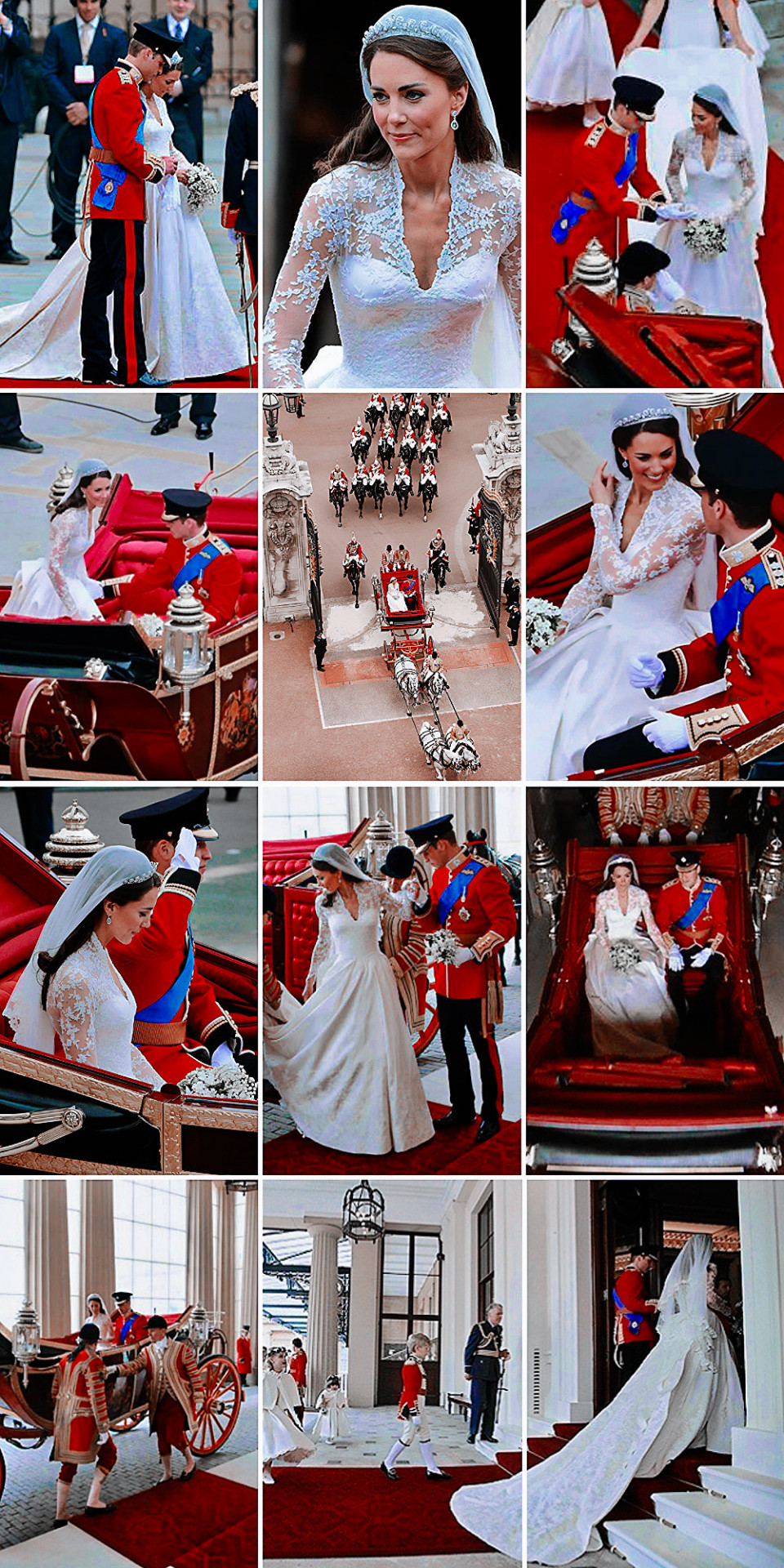
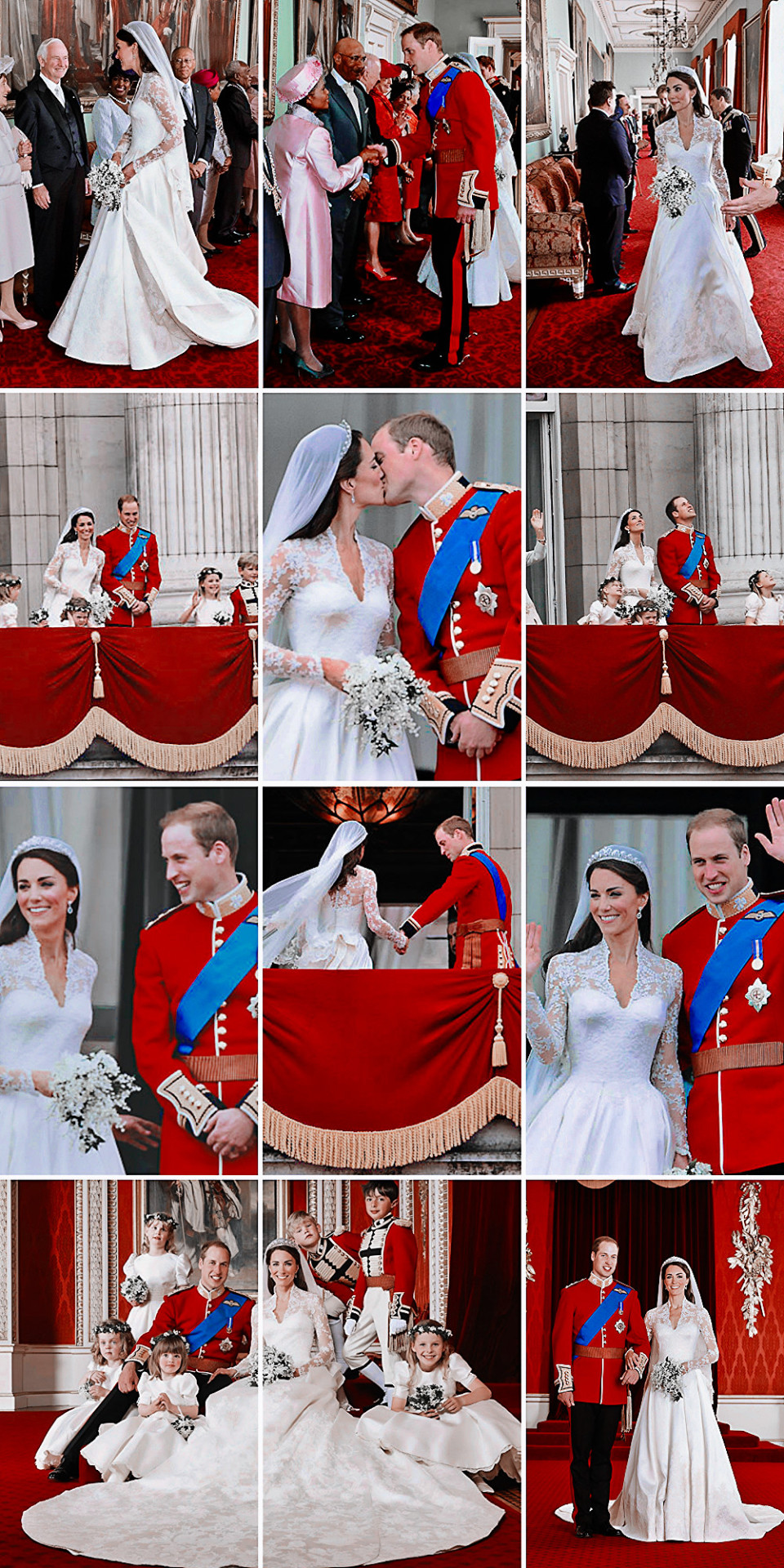
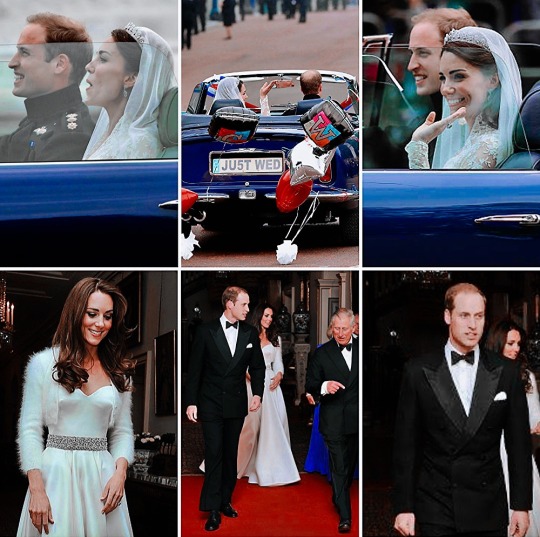
HAPPY 12TH WEDDING ANNIVERSARY TO THE PRINCE AND PRINCESS OF WALES!
HRH Prince William Arthur Philip Louis and Miss. Catherine Elizabeth Middleton married in a religious ceremony on 29 April 2011 at Westminster Abbey in London.
Will and Cat were married by the Archbishop of Canterbury, while the Dean of Windsor conducted the ceremony and the Bishop of London gave the address.
Catherine wore a dress by Surah Burton of Alexander McQueen. The Royal School of Needlework's hand-made lace applique for the bodice and skirt incorporated the rose, thistle, daffodil and shamrock. She was lent the Cartier Scroll Tiara by her grandmother-in-law and gifted a pair of diamond earrings featuring acorns from Robinson Pelham by her parents for the special day. The bridal bouquet featured myrtle, lily-of-the-valley, sweet William, ivy, and hyacinth.
William doned on the red tunic of the Colonel of the Irish Guards uniform with a forage cap bearing the Irish Guards insignia and motto, "Quis Separabit?. He wore the Order of the Garter Star and Blue Riband to which his RAF Wings & Golden Jubilee Medal were fastened.
Upon their wedding they were conferred upon the titles of The Duke and Duchess of Cambridge, Earl & Countess of Strathearn and Baron and Lady Carrickfergus by Queen Elizabeth II.
Following the ceremony in true fairytale fashion, the new Duke and Duchess of Cambridge travelled in the 1902 State Landau in a horse-drawn carriage procession to Buckingham Palace. They appeared on the Palace Balcony for a RAF Flypast and shared TWO KISSES to the delight of the crowd gathered below and my 11 year old self's.
The official wedding photos of the couple with their families and wedding party were taken by Hugo Burnand in the throne room of Buckingham Palace.
A Reception for the couple and their guests was hosted at Buckingham Palace by The Queen while the then Prince of Wales hosted a further private dinner. The couple'a guests had two wedding cakes to choose from - a multi-tiered traditional fruit cake crafted by Fiona Cairns & William's favourite chocolate biscuit cake.
William and Catherine drove to Clarence House following the lunchtime reception in a blue, two seat Aston Martin DB6 Volante which was originally a 21st birthday gift to the then Prince of Wales by the Queen.
William and Catherine have three children Prince George, Princess Charlotte and Prince Louis. The family of five they divide time between their official residence at Kensington Palace in London and their two private residences Amner Hall in Norfolk & Adelaide Cottage in Windsor.
They became The Duke and Duchess of Cornwall and The Duke and Duchess of Rothesay after King Charles III's accession to the throne and were made The Prince and Princess of Wales by him on 9 September 2022.
As well as undertaking royal duties in support of The King, both in the UK and overseas, The Prince and Princess devote their time to supporting a number of charitable causes and organisations with some of their key areas of interest being Early Childhood Development, Mental Health, Conservation, Arts, Sports etc.
#princess of wales#the princess of wales#princess catherine#prince william#prince of wales#the prince of wales#the prince and princess of wales#prince and princess of wales#british royal family#british royals#royalty#royals#brf#british royalty#kate middleton#catherine middleton#duchess of cambridge#royal#duke of cambridge#the duke and duchess of cambridge#willcat's royal wedding#royal wedding#my edit.#my photoset.#happy wedding 12th anniversary will & cat#happy wedding anniversary will & cat#willcat's 12th anniversary#pippa matthews#pippa middleton#michael middleton
178 notes
·
View notes
Note
i love your trans dragon embroidery!! i don’t know a lot about it yet, but i’ve been looking into techniques to learn and i was wondering if there was a name for the stitch you used to fill the body colours on the dragon? i love how it looks, so nice and flat and even
Hey there! Thank you so much. Sorry in advance this is long, i just really fucking like talking about the topic, and I'm actually really used to helping newbies get started.
The fill is entirely 'long and short stitch' throughout the entire piece. It's normally used the most in the technique called 'thread painting' which usually aims for photorealism and involves swapping out a lot of colors to achieve a smooth color transition. I instead do one solid color for my fills, and rely on the thread direction + refraction of light to give it depth. That's a style choice vs it being exactly normal or usual - like any art, embroidery artists develop a recognizable style even when using different stitches or approaches to their work.
I mention the above caveats because here's a guide from the Royal School of Needlework showing how long and short stitch is worked. It shows it as it's most normally used - very careful planning of the stitches to achieve closer to lifelike shading, and swapping out colors at junctions. Thread direction still matters even when you use different colors for shading as shown in that guide. The goal no matter what when using mercerized cotton or silk floss for this is to make it as smooth as possible so that it's glossy and reflects light. Back to my art style - without color changes, the animals or fabrics or whatever I'm embroidering long and short on, the end result of controlling the thread direction is that it looks far more lifelike and has depth, such as in this photo from the original post, where you can see how the light hits different twists and turns.

The light reflecting differently on different parts is a key part of my style - it's not a happy accident and that is why it looks as nice as it does, it's the most important part imo, because even if the long and short stitch was done correctly, it might look odd or not be the look I wanted if say, I made all my thread simply point up and down. I had to choose as I went how I wanted the components that make up the dragon to contrast and work with each other, since it is a very smooth and even surface, to provide the visual interest. The wings being entirely smooth and slick with their different color sections, the grip of the claws, the way the muscles work over each other on the legs, the scales being outlined and interrupting the flow - these all build within the composition of the piece to help direct the eye.
My original pattern I used doesn't have instructions on that, it's basically a stencil. However modern patterns aimed at teaching this technique do show where to direct and angle your floss in order to get the correct result: nice and flat and evenly shiny. If you're interested in the photorealism aspect of long and short stitch, check out Michelle Staub, who has a very excellent book that teaches both the stitch techniques and how to blend colors. Stitching animals with fur direction is a good way to get a handle on how rendering fur and muscles works.
#chatter#embroidery help#that should probably be a tag i guess! i do like talking about how the sausage gets made
29 notes
·
View notes
Text
A first glimpse at Their Majesties' Coronation robes...
Ahead of Their Majesties' Coronation on Saturday, new details have been released to provide a glimpse of the Coronation Robes to be worn by The King and The Queen Consort on Saturday 6th May.
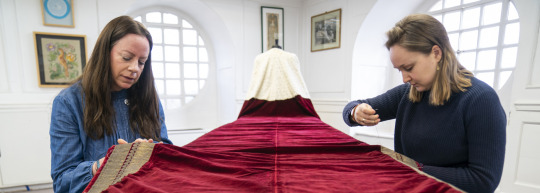
In accordance with tradition, Their Majesties will wear two different sets of robes during the Coronation Service - the Robes of State and the Robes of Estate. Robes of State are worn on arrival at Westminster Abbey, and Robes of Estate are worn on departure, following the Coronation Service, and are traditionally more personalised in design.
The new images show the Royal School of Needlework’s embroidery team conserving The King’s Robe of State, which will be worn by His Majesty on arrival at Westminster Abbey, and The Queen Consort’s Robe of Estate, which will be worn after Her Majesty is crowned, on departure from Westminster Abbey. As Duchess of Cornwall, The Queen Consort became Patron of the Royal School of Needlework in 2017.
All four robes will be seen in full on the day of the Coronation.
His Majesty’s Robe of State (to be worn on arrival)

The King’s Robe of State is made of crimson velvet and was worn by King George VI at the Coronation in 1937. In preparation for the Coronation Service, the velvet has been conserved by the Royal School of Needlework, with the lining and gold lace conserved by Ede and Ravenscroft.
Her Majesty’s Robe of State (to be worn on arrival)
The Robe of State to be worn by The Queen Consort was originally made for Queen Elizabeth II in 1953. The Robe is made of crimson velvet and has been conserved with adjustments made by robemakers at Ede and Ravenscroft ahead of the Coronation.
His Majesty’s Robe of Estate (to be worn on departure)
The King’s Robe of Estate is made of purple silk velvet embroidered in gold and was worn by King George VI in 1937. Robemakers at Ede and Ravenscroft have conserved and prepared the robe ahead of the Coronation.
Her Majesty’s Robe of Estate (to be worn on departure)
The Queen Consort’s new Robe of Estate was designed and hand embroidered by the Royal School of Needlework. The Robe itself was made by Ede and Ravenscroft.

The Royal School of Needlework’s design of the train draws on the themes of nature and the environment, featuring the national emblems of the United Kingdom, as well as paying tribute to His Majesty The King.
The Robe uses a rich purple velvet, chosen to match His Majesty’s Robe of Estate, and has been embroidered by the Royal School of Needlework using the Goldwork technique, with the design also incorporating Her Majesty’s cypher.
For the first time, insects including bees and a beetle feature on the Coronation Robe, drawing on the themes of nature and the environment and reflecting Their Majesties’ affection for the natural world.
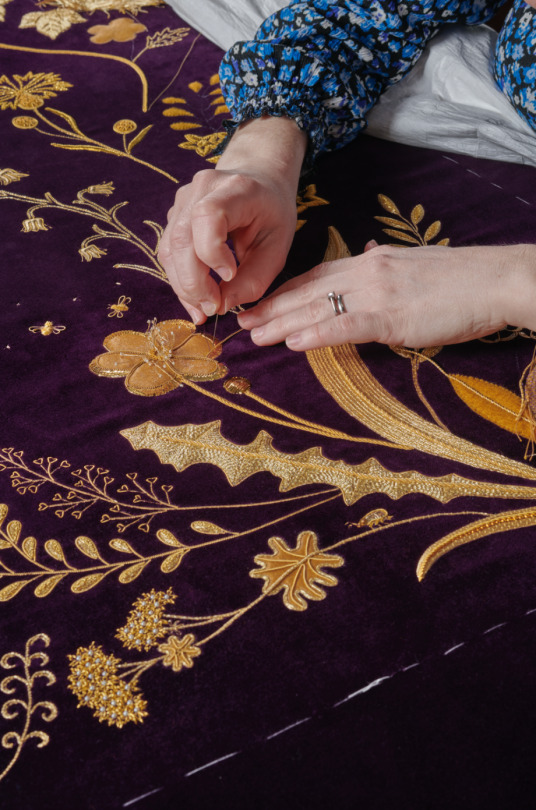
In addition, there are a number of plants featured in the robe, all chosen for their personal associations. These include Lily of the Valley, which featured in Her Majesty’s wedding bouquet and was a favourite flower of Queen Elizabeth II; Myrtle, which represents hope; and Delphinium, one of The King’s favourite flowers and the birth flower of July, the birth month of The Queen Consort.
Also featured is the ‘Alchemilla Mollis’, known as Lady’s Mantle, which symbolises love and comfort, Maidenhair Fern, which symbolises purity, and cornflowers, which represent love and tenderness. The Cornflower also helps to attract and encourage wildlife such as bees and butterflies.
93 notes
·
View notes
Text
the royal school of needlework is doing an online zoom talk about the history of queer needlework & i signed up so fucking fast
12 notes
·
View notes
Text
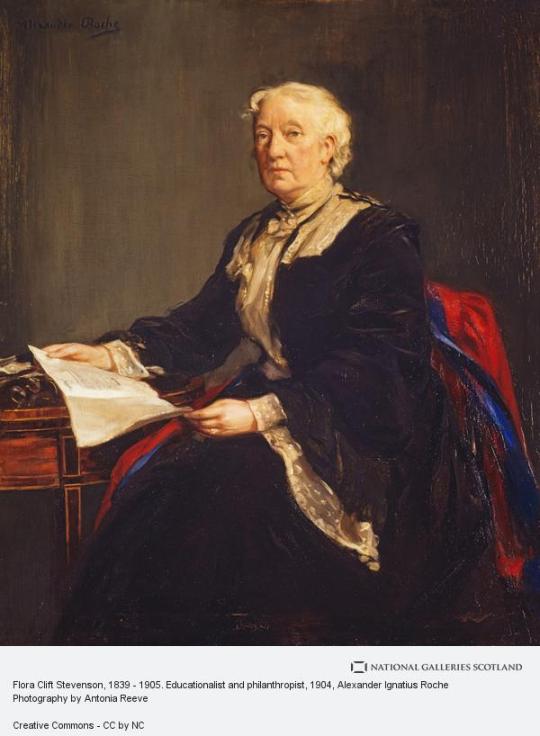

Flora Clift Stevenson the social reformer and suffragette was born on 30th October 1839.
Born into a merchant family in Glasgow the youngest of 11 children. Her father was a wealthy Glasgow industrialist; when he retired the family moved to Edinburgh, and Flora spent most of her adult life living at 13 Randolph Crescent in the West End with her 3 sisters. The Stevenson sisters were all active in the mid-nineteenth century Scottish women’s movement. They all supported women’s suffrage, and were founding members of the Edinburgh Ladies’ Educational Association which was founded in 1868 to campaign for higher education for women. Flora was also committed to improving education for society’s poorest children; as a child she started a class in her home to teach messenger girls basic reading, writing, and maths skills.
In 1863 Flora joined the Edinburgh Association for Improving the Condition of the Poor as a district visitor, investigating the circumstances of charity claimants and assessing whether or not they were ‘deserving’ of support. She also joined the committee of the United Industrial Schools of Edinburgh, a voluntary body that organised schools for poor children. Flora believed that compulsory school attendance was central to improving the lives of poor children in big cities.
In 1873 Flora was elected to the newly formed school board for Edinburgh. School boards were the first public bodies in Scotland which were open to women. As a result of her experience she was placed on the destitute children’s committee, where she was responsible for a scheme that gave food and clothes to poor children on the condition that they attended school. She also persuaded the school board to set up a day school for truants and juvenile delinquents, which was the first of its kind under the control of a school board. Flora’s expertise in this area was well respected; she served on several committees advising the government.
Flora’s belief in women’s rights carried over into her educational philosophy. She believed that girls and boys should be treated the same in education, and argued against the school board’s policy of giving girls 5 hours less teaching than boys every week so they could practice needlework. She believed that boys should be taught household management as well as girls, and that unmarried female teachers should receive equal pay.
Flora’s dedication to Edinburgh’s education system was respected and acknowledged. In 1899 a new primary school in Craigleith was named after her, and in 1900 she was unanimously elected to the Chair of the Edinburgh school board. In 1903 she was awarded an honorary degree by the University of Edinburgh, and two years later she was given the Freedom of the City in recognition of her service to Edinburgh’s philanthropic institutions and the school board. When she died in September 1905, thousands of schoolchildren lined the route of her funeral. She is buried with her family in Dean Cemetery in Edinburgh.
In August 2021 The Royal Bank of Scotland issued a new £50 note with Flora Stevenson on it.
12 notes
·
View notes
Text
The Anointing Screen
The Anointing Screen has been designed and produced for use at the most sacred moment of the Coronation, the Anointing of His Majesty The King. The screen combines traditional and contemporary sustainable embroidery practices to produce a design which speaks to His Majesty The King’s deep affection for the Commonwealth. The screen has been gifted for the occasion by the City of London Corporation and City Livery Companies.

The Anointing takes place before the investiture and crowning of His Majesty. The Dean of Westminster pours holy oil from the Ampulla into the Coronation Spoon, and the Archbishop of Canterbury anoints the Sovereign on the hands, chest and head. It has historically been regarded as a moment between the Sovereign and God, with a screen or canopy in place given the sanctity of the Anointing.
The Anointing Screen was designed by iconographer Aidan Hart and brought to life through both hand and digital embroidery, managed by the Royal School of Needlework. The central design takes the form of a tree which includes 56 representing the 56 member countries of the Commonwealth. The King’s cypher is positioned at the base of the tree, representing the Sovereign as servant of their people. The design has been selected personally by The King and is inspired by the stained-glass Sanctuary Window in the Chapel Royal at St James’s Palace, which was gifted by the Livery Companies to mark the Golden Jubilee of Queen Elizabeth II in 2002.
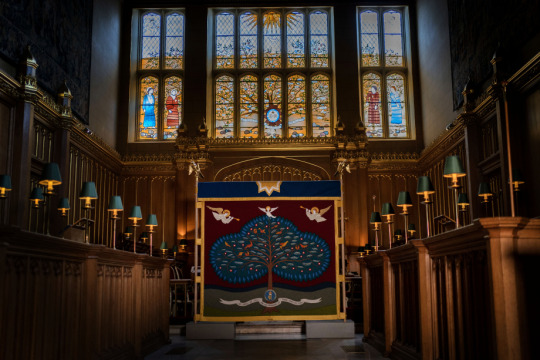
The Anointing Screen is supported by a wooden pole framework, designed and created by Nick Gutfreund of the Worshipful Company of Carpenters. The oak wooden poles are made from a windblown tree from the Windsor Estate, which was originally planted by The Duke of Northumberland in 1765. The wooden poles have been limed and waxed, combining traditional craft skills with a contemporary finish.
At the top of the wooden poles are mounted two eagles, cast in bronze and gilded in gold leaf, giving the screens a total height of 2.6 metres and width of 2.2 metres. The form of an eagle has longstanding associations with Coronations. Eagles have appeared on previous Coronation Canopies, including the canopy used by Queen Elizabeth II in 1953. Equally, the Ampulla, which carries the Chrism oil used for anointing, is cast in the shape of an eagle.

The screen is three-sided, with the open side to face the High Altar in Westminster Abbey. The two sides of the screen feature a much simpler design with maroon fabric and a gold, blue and red cross inspired by the colours and patterning of the Cosmati Pavement at Westminster Abbey where the Anointing will take place. The crosses were also embroidered by the Royal School of Needlework’s studio team.
At the Coronation Service, the Anointing Screen will be held by service personnel from Regiments of the Household Division holding the Freedom of the City of London. The three sides of the screen will be borne by a Trooper and Guardsman from each of The Life Guards, Grenadier Guards, Coldstream Guards, Scots Guards, Irish Guards, and Welsh Guards.
The screen has been gifted for the Coronation by the City of London Corporation and participating Livery Companies, the City’s ancient and modern trade guilds. His Majesty The King is a keen advocate and supporter of the preservation of heritage craft skills, and the Anointing Screen project has been a collaboration of these specialists in traditional crafts, from those early in their careers to artisans with many years of experience.
The individual leaves have been embroidered by staff and students from the Royal School of Needlework, as well as members of the Worshipful Company of Broderers, Drapers and Weavers.
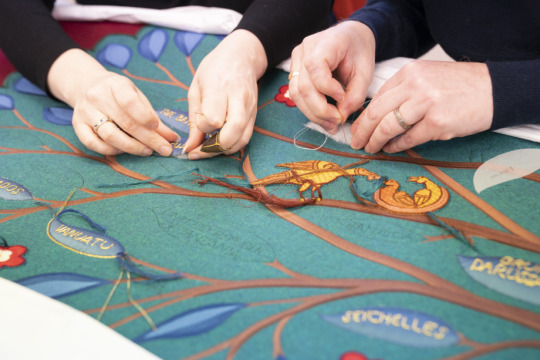
As well as heritage craft, contemporary skills and techniques have formed part of this unique collaboration. The outline of the tree has been created using digital machine embroidery by Digitek Embroidery. This machine embroidery was completed with sustainable thread, Madeira Sensa, made from 100% lyocell fibres.
The threads used by the Royal School of Needlework are from their famous ‘Wall of Wool’ and existing supplies that have been collated over the years through past projects and donations. The materials used to create the Anointing Screen have also been sourced sustainably from across the UK and other Commonwealth nations. The cloth is made of wool from Australia and New Zealand, woven and finished in UK mills.
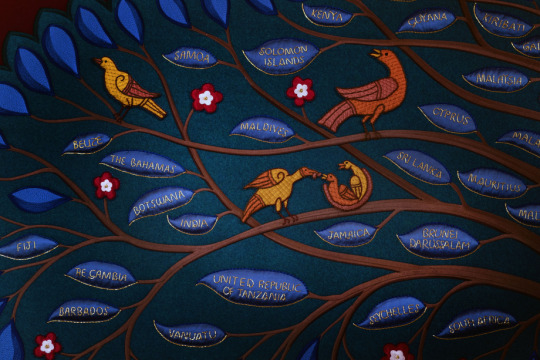
The script used for the names of each Commonwealth country has been designed as modern and classical, inspired by both the Roman Trojan column letters and the work of Welsh calligrapher David Jones.
Also forming part of the Commonwealth tree are The King’s Cypher, decorative roses, angels and a scroll, which features the quote from Julian of Norwich (c. 1343-1416): ‘All shall be well and all manner of thing shall be well’.
This design has again been inspired by the Sanctuary Window in the Chapel Royal, St James’s Palace, created for Queen Elizabeth II’s Golden Jubilee in 2002. At the top of the screen is the sun, representing God, and birds including the dove of peace, which have all been hand embroidered by the Royal School of Needlework.
The dedication and blessing of the Anointing Screen took place earlier this week at the Chapel Royal, St James’s Palace, where it was officially received and blessed by the Sub-Dean and Domestic Chaplain to The King, Paul Wright, on behalf of The Royal Household.
117 notes
·
View notes
Note
Has anyone discussed her coronation dress? I haven’t my seen any discussion anywhere, which surprises me. I’m curious about the protocol. It has to be a cream gown, no? The historical gowns were all embroidered, but I bet she references her wedding gown with some lace. I’m very curious to see if she upgrades the tiara. It will probably be a McQueen, but if she wears Erdem I will be absolutely deceased.
My own personal theory is that Kate will wear the McQueen gown for her wedding reception but with new embroidery and lace on it from Sarah Burton and the Royal School of Needlework. It's a simple enough dress that it can work. Trade the chunky belt for one of Queen Mary's stomachers in the royal vault that no one's seen for 80 years and the CLK tiara.
(It's never going to happen since my track record in guessing Kate's outfits is a big fat zero but that is my dream.)
Oooooooooh. That is an intriguing thought. I bet it's strapless underneath, but she could do an embroidered or lace-based coverup. I like this idea, but with the Girls Tiara and matching embroidery on the cover-up.

30 notes
·
View notes
Text

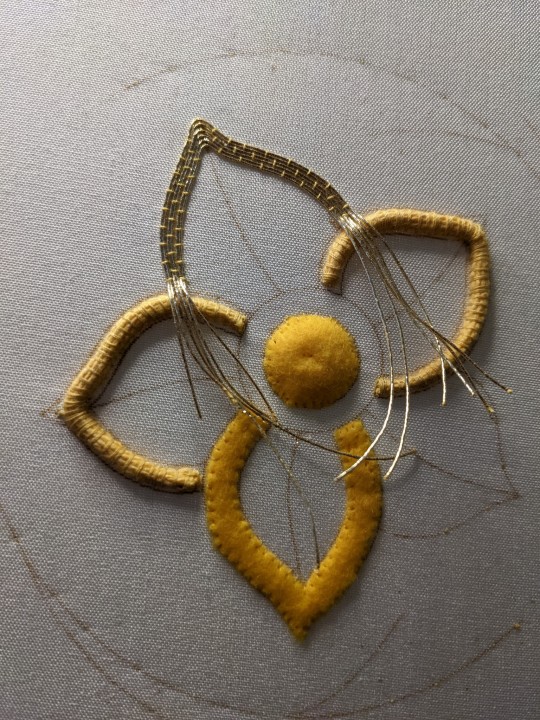
Completed row three. You can start to see the brick pattern.
#embroidery#hand embroidery#needlework#royal school of needlework#crafts#fabric crafts#needlecraft#goldwork
6 notes
·
View notes
Text
Court Circular | 21st March 2023
Buckingham Palace
The King, Sovereign of the Order, was present this morning at a Service of the Royal Victorian Order held in St George’s Chapel, Windsor Castle.
The Duke and Duchess of Edinburgh, The Princess Royal, Grand Master of the Order, accompanied by Vice Admiral Sir Tim Laurence, and The Duke and Duchess of Gloucester were also present.
His Majesty was received by the Dean of Windsor (the Right Reverend David Conner) and the Chaplain of the Order (the Reverend Canon Thomas Woodhouse).
Detachments of His Majesty’s Body Guard of the Honourable Corps of Gentlemen at Arms, The King’s Body Guard of the Yeomen of the Guard and the Military Knights of Windsor were on duty in St George’s Chapel.
Afterwards The King gave a Reception at Windsor Castle for those who attended the Service.
The King and The Queen Consort, Patron, this afternoon visited the Royal School of Needlework at Hampton Court Palace, East Molesey, Surrey, and were received by the Chief Executive of Historic Royal Palaces (Mr John Barnes) and the Chairman of the Royal School of Needlework (Ms P Wood).
Their Majesties, escorted by Dr Susan Kay-Williams (Chief Executive, Royal School of Needlework), viewed the progress of work being undertaken for the Coronation by embroiderers and other members of Royal School of Needlework staff, before viewing displays of objects from past Coronations from the Royal School of Needlework Archive and Collection and objects from the Historic Royal Palaces Collection.
Kensington Palace
The Prince of Wales, President, the Earthshot Prize, this morning held a Meeting.
The Princess of Wales, Joint Patron, the Royal Foundation of The Prince and Princess of Wales, this morning held a Meeting to launch a Business Taskforce for Early Childhood, NatWest Head Office, 250 Bishopsgate, London EC2.
St James’s Palace
The Duke of Kent, Patron, St Mungo’s, this morning visited the Grange Road Service at 41-43, Crimscott Street, London SE1, and was received by Colonel Simon Duckworth (Deputy Lieutenant of Greater London).
#court circular#princess anne#princess royal#tim laurence#king charles iii#queen camilla#prince william prince of wales#catherine princess of wales#prince richard duke of gloucester#birgitte duchess of gloucester#prince edward duke of edinburgh#sophie duchess of edinburgh#prince edward duke of kent#british royal family
16 notes
·
View notes
Text
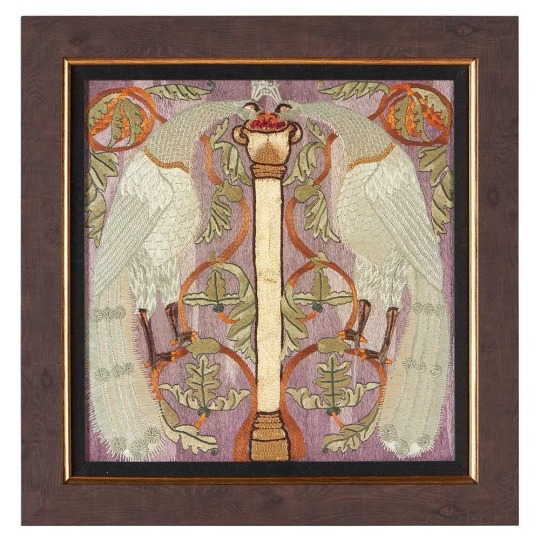
WALTER CRANE (1845-1915) (ATTRIBUTED DESIGNER) FOR THE ROYAL SCHOOL OF NEEDLEWORK
EMBROIDERED PANEL CIRCA 1890
coloured silks and gold thread with applied beads, later frame
Lyon and Turnbull
15 notes
·
View notes